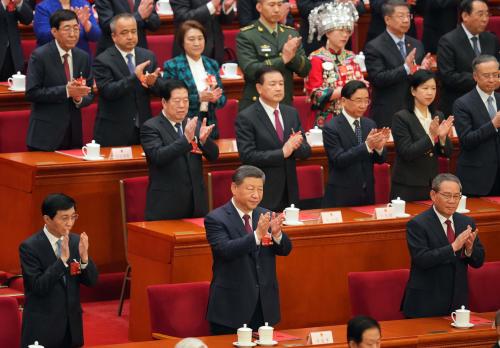Content from the Brookings Institution India Center is now archived. After seven years of an impactful partnership, as of September 11, 2020, Brookings India is now the Centre for Social and Economic Progress, an independent public policy institution based in India.
BRICS (Brazil, Russia, India, China and South Africa) is a formidable economic and political force to reckon with. The high economic growth of the BRICS economies and their demographic dividends indicate a structural edge possessed by the BRICS economies relative to the rest of the world. In 2015 with 53.4 per cent of the world’s population, BRICS countries accounted for a total nominal GDP of US$16.92 trillion — equivalent to 23.1 per cent of global GDP. In the same year, BRICS accounted for 19.1 per cent of world exports and, between 2006 and 2015, intra-BRICS trade increased 163 per cent from US$93 billion to US$244 billion.
In October 2016, India will chair the eighth annual BRICS summit in Goa. The eighth summit promises to have a focus on Asia with the leaders of Afghanistan and the Maldives invited, as well as occurring alongside a meeting between BRICS and the Bay of Bengal Initiative for Multi-Sectoral Technical and Economic Cooperation (BIMSTEC). This is an international organisation comprising a group of countries including Bangladesh, India, Myanmar, Sri Lanka, Thailand, Bhutan and Nepal.
India’s core themes as it chairs BRICS will be building responsive, inclusive and collective solutions for the grouping. According to the Ministry of External Affairs, India will adopt a five-pronged approach comprising institution building, implementation, integration, innovation and continuity with consolidation. India’s emphasis will be on carrying out previous commitments flowing from past summits and exploring synergies among the existing political and economic mechanisms. The grouping has been pushing for greater economic growth among the member countries and reform of global financial institutions.
In recent years, India has been the brightest spot in the grouping and is currently one of the fastest growing economies in the world. Chairing the BRICS summit provides India with a good opportunity to drive its own agenda of increasing investment in its priority projects, especially in the infrastructure sector, and discussing trade barriers.
India is expected to seek cooperation on standards and technical regulations and propose a mechanism to resolve issues relating to non-tariff barriers hurting trade between BRICS member countries. India is also hoping for a visa pact in the current summit to allow multiple-entry business visas for longer periods of time.
An important aspect of the summit will be the strengthening of the BRICS–G20 relationship. Innovation and inclusiveness formed part of the G20’s agenda and will be a focus of the BRICS summit too. This will provide an opportunity to further enhance cooperation in global governance with a focus on innovative and sustainable development.
Recently the idea of a floundering BRICS has also been discussed. With the economies of Russia and Brazil lagging behind because of the crash in oil and commodity prices, and both China and South Africa in the midst of major domestic turmoil, India — which is becoming the world’s most favoured destination for FDI — is certainly an outlier in the group. Undoubtedly the cooperation between BRICS members could be limited by the slowdown in these economies, but the strategic and economic opportunities India has as a member are far greater than if it were not.
At the same time, India–China relations could get in the way of BRICS functionality. China’s consistent efforts to establish its status as the premier regional power increases the risk of divergence and friction. India’s ability to use the BRICS summit to raise its international stature will be limited as long as Indian and Chinese economic interests do not align.
It remains to be seen whether these two countries will cooperate or continue to compete with each other. In the meantime, it would be best for India to use the summit to showcase its own achievements and try to increase investment in India’s infrastructure development.
India should also use the summit to strengthen the existing multilateral and bilateral relations between member countries and work towards increasing the competitiveness and economic growth of the BRICS economies so that the partnership remains intact.
Forums like BRICS help bring countries together and coordinate approaches to tackling the challenges confronting the global economy. As chair, India has the opportunity to steer the BRICS nations in the right direction while also providing many opportunities domestically.
This article first appeared in East Asia Forum on 8 October 2016. Like other products of the Brookings Institution India Center, this article is intended to contribute to discussion and stimulate debate on important issues. The views are of the author(s) and discussants(s). Brookings India does not have any institutional views.
The Brookings Institution is committed to quality, independence, and impact.
We are supported by a diverse array of funders. In line with our values and policies, each Brookings publication represents the sole views of its author(s).



Commentary
Op-edImportant aspect of BRICS Summit will be strengthening of BRICS–G20 relationship
East Asia Forum
October 12, 2016